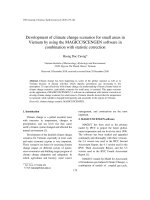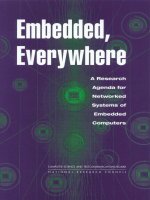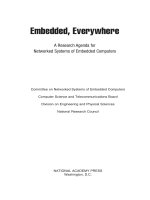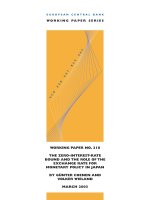The research proposal for recommender systems in academic domain using social network analysis approach
Bạn đang xem bản rút gọn của tài liệu. Xem và tải ngay bản đầy đủ của tài liệu tại đây (1.04 MB, 11 trang )
The Research Proposal for Recommender
Systems in Academic Domain using Social
Network Analysis Approach
Tin Huynh
University of Information Technology - Vietnam,
Km 20, Hanoi Highway, Linh Trung Ward, Thu Duc District, HCMC.
Abstract. In this paper, we present our research proposal based on social network analysis approach to develop recommender systems in the
academic domain. Recommender system is a solution that can help users
deal with the flood of information returned by search engines. Recommender systems are widely used nowadays, especially in E-Commerce,
but it has not received enough attention in the academic domain. The
traditional approaches for recommendation do not mention relationships
which can effect to behaviors and interests of individuals. Therefore, we
applied the Social Network Analysis approach combining with traditional
methods to develop recommender systems.
Keywords: social network analysis, recommender system, collaborative
knowledge network.
1
Introduction
The explosive growth and complexity of information that is added to the Web
daily challenges all search engines. One solution that can help users deal with
flood of information returned by search engines is recommendation. Recommender systems identify user’s interests through various methods and provide
specific information for users based on their needs. Rather than requiring users
to search for information, recommender systems proactively suggest content to
users [34]. A well-known statement of Anderson, ”We are leaving the age of information and entering the age of recommendation”, have been used as a slogan for
the RecSys (ACM Conference on Recommender Systems)1 that is a well-known
conference on recommender systems of ACM. It showed that recommender systems have attracted the attention of the research community.
Adomavicius and Tuzhilin provide a survey of the state-of-the-art and possible extensions for recommender systems [3]. Traditional recommender systems
are usually divided into three categories: (1) content-based filtering; (2) collaborative filtering and (3) hybrid recommendation systems [3]. Content-based
1
Transactions of the UIT Doctoral Workshop, Vol 1, pp. 57-67, 2012.
58
Tin Huynh
Community
User Groups have
similar interest
Rating/interesting
items
Identifying similar items
based on its content
a1
G1
b1
a1
a2
a3
b1
b2
b3
c1
c2
c3
d1
d2
d3
c1
G2
a1
c1
G3
b1
d1
Items should be
recommended for
G1
Fig. 1. Content-based filtering
approaches compare the contents of the item to the contents of items in which
the user has previously shown interest (figure 1). Collaborative Filtering (CF)
determines similarity based on collective user-item interactions, rather than on
any explicit content of the items (figure 2). These traditional approaches do not
mention relationships which can effect to behaviors and interests of individuals.
Combining the social network analysis approach with traditional approaches can
help us deal with these disadvantages.
Graphical models, a ’marriage’ between probability theory and graph theory,
provide a natural tool for dealing with two problems that occur throughout applied mathematics and engineering are uncertainty and complexity [18]. Graphical Models can be considered as expressive tools for analyzing, computing and
modeling behaviors, relationships and influence of users in social networks.
In this work, we present our research proposal to do recommendations in the
academic domain based on the social network analysis approach. These recommendations aim to support activities of researchers, reviewers while doing research such as research paper recommendation, collaboration recommendation,
publication venue recommendation, paper reviewing recommendation, etc.
2
Related work
Recommender systems are widely used nowadays, especially in E-Commerce.
Park et al. collected and classified articles on recommender systems from 46 journals published between 2001 and 2010 to understand the trend of recommender
Recommender Systems in Academic Domain using Social Network Analysis Approach
Rating/interesting
items
Community
59
Identifying users who
have similar interests
a
U1
b
c
a
Collaborative
Filtering
algorithms
U1
b
U2
d
U2
U3
Recommendations:
Item ‘d’ should be
recommended for
U1, item ‘c’ for U2
and items ‘c’, ’d’ for
U3
a
b
U3
Fig. 2. collaborative filtering
system research and to provide practitioners and researchers with insight and
future direction on recommender systems [31]. Their statistical numbers showed
that recommender systems have attracted the attention of academics and practitioners. The majority of those research papers relates to movie (53 out of
210 research papers, or 25.2%) and shopping (42 out of 210 research papers,
or 20.0%) [31]. In another research, Li et al. said that the utilization of recommender system in academic research itself has not received enough attention
[21].
The online world has supported the creation of many research-focused digital
libraries such as the Web of Science, ACM Portal, Springer Link, IEEE Xplore,
Google Scholar, and CiteSeerX. Initially, these were viewed as somewhat static
collections of research literature. These traditional digital libraries and search
engines support the discovery of relevant documents but they do not traditionally
provide community-based services such searching for people who share similar
research interests. Recently, new research is focusing on these as enablers of a
community of scholars, building and analyzing social networks of researchers
to extract useful information about research domains, user behaviors, and the
relationships between individual researchers and the community as a whole.
Microsoft Academic Search, ArNetMiner [36], and AcaSoNet [2] are online,
web-based systems whose goal is to identify and support communities of scholars
via their publications. The entire field of social network systems for the academic
community is growing quickly, as evidenced by the number of other approaches
being investigated [1][28][27][6][26].
As we mentioned above, traditional recommender systems are usually divided into three categories: (1) content-based filtering; (2) collaborative filtering
60
Tin Huynh
and (3) hybrid recommendation systems [3]. Content-based approaches compare the contents of the item to the contents of items in which the user has
previously shown interest. Automated text categorization is considered as the
core of content-based recommendation systems. This supervised learning task
assigns pre-defined category labels to new documents based on the document’s
likelihood of belonging to a given class as represented by a training set of labeled documents [39]. Yang et al. reported a controlled study with statistical
significance tests on five text categorization methods: Support Vector Machines
(SVM), k-Nearest Neighbors (kNN) classifier, neural network approach, Linear
Least-squares Fit mapping and a Nave Bayes classifier [39]. Their experiments
with the Reuters data set showed that SVM and kNN significantly outperform
the other classifiers, while Nave Bayes underperforms all the other classifiers.
In other work, kNN was found to be an effective and easy to implement that
could, with appropriate feature selection and weighting, outperform SVM [9].
So, kNN was considered as a baseline to compare with our proposed methods
for the publication venue recommendation problem [25].
Collaborative Filtering (CF) determines similarity based on collective useritem interactions, rather than on any explicit content of the items. Su et al. has
summarized a detail review of some main CF recommendation techniques [35].
There are two main methods in CF: (i) memory-based; and (ii) model-based.
Memory-based algorithms operate on the entire user-item rating matrix and
generate recommendations by identifying a neighborhood for the target user to
whom the recommendations will be made, based on the agreement of user’s past
ratings. Memory-based techniques have some drawback including the sparsity of
the user-item rating matrix due to the fact that each user rates only a small subset of the available items and inefficient computation of the similarity between
every pair of users (or items) within large-scale datasets. To deal with challenges
associated with the sparse and high dimensional dataset in the research paper domain, Lance Parsons et al. presented a survey of the various subspace clustering
algorithms. They also compared the two main approaches to subspace clustering
and discussed some potential applications where subspace clustering could be
particularly useful [32]. Agarwal et al. proposed a scalable subspace clustering
algorithm ScuBA which can be applied for research paper recommender systems
and for research group collaboration. They took advantage of the unique characteristics of the data in the research paper domain and provided a solution which
is fast, scalable and produced high quality recommendations [4][5].
To overcome the weaknesses of memory-based techniques new research focuses on model-based clustering techniques including social network-based or
clustering techniques using social information that aim to provide more accurate, yet more efficient, methods. Pham et al. proposed model-based techniques
that use the rating data to train a model and then the model is used to derive the
recommendations [33]. In another recommendation research using CF, Li et al.
proposes a basket-sensitive random walk model for personalized recommendation in the grocery shopping domain. Their proposed method extends the basic
random walk model by calculating the product similarities through a weighted
Recommender Systems in Academic Domain using Social Network Analysis Approach
61
bipartite network and allowing the current shopping behaviors to influence the
product ranking scores [22]. In general, the basic idea of the traditional recommendation approaches is to discover users with similar interests or items with
similar characteristics or the combination of these. The traditional approaches
do not mention the relationship which can effect to the behavior and the interest
of individuals.
Social network analysis (SNA) is a quantitative analysis of relationships between individuals or organizations to identify most important actors, group formations or equivalent roles of actors within a social network [19]. SNA is considered a practical method to improve knowledge sharing and it is being applied in
a wide variety of contexts [29]. However studies on recommender systems using
social network analysis are still deficient. Therefore, developing the recommendation system research using social network analysis will be an interesting area
further research [31]. In particular, Kirchhoff et al. [19][20] and Gou et al. [11]
apply SNA to enhance an information retrieval (IR) systems. Xu et al and Liu
et al applied SNA to detect terrorist crime groups [37][23].
New research recently focuses on SNA approach and also the combination
of the traditional approaches and the SNA to bring out better recommendations. Jianming He et al. presented a social network-based recommender system
(SNRS) which makes recommendations by considering a user’s own preference,
an item’s general acceptance and influence from friends [12]. They collected data
from a real online social network and their analyzing on this dataset reveals that
friends have a tendency to review the same restaurants and give similar ratings. Their experiments with the same dataset shown that SNRS outperformed
than other methods, such as collaborative filtering (CF), friend average (FA),
weighted friends (WVF) and naive Bayes (NB). Yunhong Xu et al. presented
using social network analysis as a strategy for E-Commerce Recommendation
[38]. Walter Carrer-Neto et al presented a hybrid recommender system based on
knowledge and social networks. Their experiments in the movie domain shown
promising results compared to traditional methods [7].
Recently, it has emerged some researches applied social network analysis in
the academic area such as building a social network system for analyzing publication activities of researchers [2], research paper recommendation [16][30][21][10],
collaboration recommendation [8][24], publication venue recommendation [25][33].
In order to extracting useful information from an academic social network Zhuang
et al. proposed a set of novel heuristics to automatically discover prestigious
(and low quality) conferences by mining the characteristics of Program Committee members [40]. Chen et al. introduces CollabSeer, a system that considers
both the structure of a co-author network and an author’s research interests for
collaborator recommendation [8]. CollabSeer suggests a different list of collaborators to different users by considering their position in the co-authoring network
structure. In work related to publication venues recommendation, Pham et al.
proposed a clustering approach based on the social information of users to derive the recommendations [33]. They studied the application of the clustering
62
Tin Huynh
approach in two scenarios: academic venue recommendation based on collaboration information and trust-based recommendation.
In summary, traditional approaches for recommendation do not mention the
users’ relationship which can effect to the behavior and the interest of individuals.
So, we are going to apply the Social Network Analysis approach combine with
traditional methods to develop recommender systems in the academic domain
which has not received enough attention.
3
Research Procedures
3.1
Overview of our research
Sources: online
digital libraries
Crawling
PDF Publications
Extracting, integrating
metadata of publications
Indexing
Author Name
Disambiguation
Collection of
publications and their
metadata
Publications search
engine
Identifying & modeling
the social structure
Developing SNA based methods for
recommendations in the academic area
Fig. 3. A framework for SNA based recommender systems in the academic area
In order to develop SNA based methods used for recommendations in academic research field, we need to do some prepared steps or to solve some sub
Recommender Systems in Academic Domain using Social Network Analysis Approach
63
problems such as extracting, integrating metadata of publications from many
various sources, identifying and modeling the social structure from this collection. The overview of these tasks is shown in the picture 3.
3.2
Research methodology
There are many various research methodologies, but we have applied research
methods such as quantitative and qualitative analyzing methods, trial-and-error
methods, modeling methods, and experiment-and-evaluation methods.
3.3
Planing Specific Procedures
Table 1. The list of research procedures
Specific tasks
Studying the overview of recommender systems and approaches for recommendation.
Studying the fundamentals of graphical models and its
application in social network analysis.
Crawling science publications from various online.
Analyzing, extracting the bibliographical data of science
publications.
Building the collaborative network from the collection of
publications.
Modeling and analyzing collaborative behaviours of the
research community by using probability graphical approach.
Developing measures, algorithms, methods based on
probabilistic inference in the collaborative network to
improve the recommendation results in the academic
domain. (Focus on the recommendation problems such
as research paper recommendation, collaboration recommendation, publication venue recommendation.)
4
Research methodology
Survey, the quantitative and
qualitative analyzing methods
Survey, the quantitative and
qualitative analyzing methods
Experiment-and-evaluation
methods
Trial-and-error
method;
experiment-and-evaluation
methods
The quantitative and qualitative analyzing methods, the
modeling methods
The quantitative and qualitative analyzing methods, the
modeling methods
The quantitative and qualitative analyzing methods, trialand-error methods, experimentand-evaluation methods.
Our initial results
We have solved subproblems which mentioned in the picture 3 for our research
objective. We set focus on computer science publications. We proposed methods
and developed tools used for extracting and integrating metadata of computer
science publication from online digital libraries. We used JAPE grammar of
64
Tin Huynh
GATE to define rules, patterns for extracting metadata from PDF publications
[13][14]. In order to have a rich collection of computer science publications, we
developed tools and methods for integrating bibliographical data of these publications from various online digital libraries [17].
To identify and model social structure from the collection of these papers,
we proposed a collaborative knowledge model that based on graph theory and
probability measures [15]. The model and measures can be used to identify users
or groups that have same interest in the network. It is useful information for
recommendation. We also developed and improved methods based on the collaborative network analysis approach for research paper recommendation [16]
and publication venue recommendation [25].
5
Conclusion and future work
In this paper, we presented our research proposal based on social network analysis approach to develop recommender systems in the academic domain. We
did the literature review related to recommender systems, social network analysis: methods and applications. Our research problem is a interesting problem
which has attracted the attention of the research community in many different
fields such as computer science, social science. The proposed approach can be
used to fill the gap of traditional approaches. With our initial results, we believe
that the approach based on social network analysis is a potential approach. For
the future work, we have developed methods based on the science collaborative
network analysis for recommender systems in the academic area.
References
1. Abbasi, A., Altmann, J.: On the correlation between research performance and
social network analysis measures applied to research collaboration networks. In:
Proceedings of the 2011 44th Hawaii International Conference on System Sciences.
pp. 1–10. HICSS ’11, IEEE Computer Society, Washington, DC, USA (2011)
2. Abbasi, A., Altmann, J.: A social network system for analyzing publication activities of researchers. TEMEP Discussion Papers 201058, Seoul National University;
Technology Management, Economics, and Policy Program (TEMEP) (2010)
3. Adomavicius, G., Tuzhilin, A.: Toward the next generation of recommender systems: A survey of the state-of-the-art and possible extensions. IEEE Trans. on
Knowl. and Data Eng. 17, 734–749 (June 2005)
4. Agarwal, N., Haque, E., Liu, H., Parsons, L.: Research paper recommender systems: a subspace clustering approach. In: Proceedings of the 6th international
conference on Advances in Web-Age Information Management. pp. 475–491.
WAIM’05, Springer-Verlag, Berlin, Heidelberg (2005), />1007/11563952_42
5. Agarwal, N., Haque, E., Liu, H., Parsons, L.: A subspace clustering framework for
research group collaboration. IJITWE pp. 35–58 (2006)
6. Aleman-Meza, B., Nagarajan, M., Ramakrishnan, C., Ding, L., Kolari, P., Sheth,
A.P., Arpinar, I.B., Joshi, A., Finin, T.: Semantic analytics on social networks:
Recommender Systems in Academic Domain using Social Network Analysis Approach
7.
8.
9.
10.
11.
12.
13.
14.
15.
16.
17.
18.
19.
20.
21.
65
experiences in addressing the problem of conflict of interest detection. In: Proceedings of the 15th international conference on World Wide Web. pp. 407–416. WWW
’06, ACM, New York, NY, USA (2006)
Carrer-Neto, W., Hernndez-Alcaraz, M.L., Valencia-Garca, R., Garca-Snchez, F.:
Social knowledge-based recommender system. application to the movies domain.
Expert Systems with Applications 39(12), 10990 – 11000 (2012), http://www.
sciencedirect.com/science/article/pii/S0957417412004952
Chen, H.H., Gou, L., Zhang, X., Giles, C.L.: Collabseer: a search engine for collaboration discovery. In: Proceedings of the 11th annual international ACM/IEEE
joint conference on Digital libraries. pp. 231–240. JCDL ’11, ACM, New York, NY,
USA (2011), />Cunningham, P., Delany, S.J.: k-nearest neighbour classifiers. Tech. Rep. UCDCSI-2007-4, School of Computer Science and Informatics, University College
Dublin, Ireland (2007)
Ekstrand, M.D., Kannan, P., Stemper, J.A., Butler, J.T., Konstan, J.A., Riedl,
J.T.: Automatically building research reading lists. In: Proceedings of the fourth
ACM conference on Recommender systems. pp. 159–166. RecSys ’10, ACM, New
York, NY, USA (2010), />Gou, L., Zhang, X.L., Chen, H.H., Kim, J.H., Giles, C.L.: Social network document
ranking. In: Proceedings of the 10th annual joint conference on Digital libraries.
pp. 313–322. JCDL ’10, ACM, New York, NY, USA (2010)
He, J.: A social network-based recommender system. Ph.D. thesis, Los Angeles,
CA, USA (2010), aAI3437557
Huynh, T., Hoang, K.: Automatic metadata extraction from scientific papers. In:
Proceeding of IT@EDU. University of Information Technology, Phan Thiet, VietNam (2010)
Huynh, T., Hoang, K.: Gate framework based metadata extraction from scientific
papers. In: Proceedings of the Education and Management Technology (ICEMT),
2010 International Conference on. pp. 188 – 191. Cairo, Egypt (2-4 Nov 2010 2010)
Huynh, T., Hoang, K.: Modeling collaborative knowledge of publishing activities
for research recommendation. In: ICCCI 2012 (2012)
Huynh, T., Luong, H., Hoang, K., Gauch, S., Do, L., Tran, H.: Scientific publication
recommendations based on collaborative citation networks. In: Proceedings of the
3rd International Workshop on Adaptive Collaboration (AC 2012) as part of The
2012 International Conference on Collaboration Technologies and Systems (CTS
2012). pp. 316 – 321. Denver, Colorado, USA (21-25 May 2012 2012)
Huynh, T., Luong, H.P., Hoang, K.: Integrating bibliographical data of computer
science publications from online digital libraries. In: ACIIDS (3). pp. 226–235
(2012)
Jordan, M.I. (ed.): Learning in graphical models. MIT Press, Cambridge, MA,
USA (1999)
Kirchhoff, L.: Applying Social Network Analysis to Information Retrieval on the
World Wide Web. Ph.D. thesis, the University of St. Gallen, Graduate School of
Business Administration, Economics, Law and Social Sciences (HSG) (2010)
Kirchhoff, L., Stanoevska-Slabeva, K., Nicolai, T., Fleck, M., Stanoevska, K.: Using
social network analysis to enhance information retrieval systems. In: Applications
of Social Network Analysis (ASNA) (Zurich). vol. 7, pp. 1–21 (2008)
Li;, C.P.W.: Research paper recommendation with topic analysis. In: Computer
Design and Applications (ICCDA), 2010 International Conference. pp. 264–268.
IEEE (2010)
66
Tin Huynh
22. Li, M., Dias, B.M., Jarman, I., El-Deredy, W., Lisboa, P.J.: Grocery shopping
recommendations based on basket-sensitive random walk. In: Proceedings of the
15th ACM SIGKDD international conference on Knowledge discovery and data
mining. pp. 1215–1224. KDD ’09, ACM, New York, NY, USA (2009), http://
doi.acm.org/10.1145/1557019.1557150
23. Liu, Q., Tang, C., Qiao, S., Liu, Q., Wen, F.: Mining the core member of terrorist
crime group based on social network analysis. In: Proceedings of the 2007 Pacific
Asia conference on Intelligence and security informatics. pp. 311–313. PAISI’07,
Springer-Verlag, Berlin, Heidelberg (2007), />id=1763599.1763644
24. Lopes, G.R., Moro, M.M., Wives, L.K., De Oliveira, J.P.M.: Collaboration recommendation on academic social networks. In: Proceedings of the 2010 international conference on Advances in conceptual modeling: applications and challenges. pp. 190–199. ER’10, Springer-Verlag, Berlin, Heidelberg (2010), http:
//dl.acm.org/citation.cfm?id=1927973.1928011
25. Luong, H.P., Huynh, T., Gauch, S., Do, L., Hoang, K.: Publication venue recommendation using author network’s publication history. In: ACIIDS (3). pp. 426–435
(2012)
26. Matsuo, Y., Mori, J., Hamasaki, M., Nishimura, T., Takeda, H., Hasida, K.,
Ishizuka, M.: An advanced social network extraction system from the web. Journal
of Web Semantics 5 (4), 262–278 (2007)
27. Mika, P.: Flink: Semantic web technology for the extraction and analysis of social
networks. Journal of Web Semantics 3, 211–223 (2005)
28. Miki, T., Nomura, S., Ishida, T.: Semantic web link analysis to discover social relationships in academic communities. In: Proceedings of the The 2005 Symposium
on Applications and the Internet. pp. 38–45. IEEE Computer Society, Washington,
DC, USA (2005)
29. Mller-Prothmann, T.: Social network analysis: A practical method to improve
knowledge sharing. In: Hands-On Knowledge Co-Creation and Sharing. pp. 219–
233 (2007)
30. Ohta, M.; Hachiki, T.T.A.: Related paper recommendation to support onlinebrowsing of research papers. In: Applications of Digital Information and Web Technologies (ICADIWT), 2011 Fourth International Conference. pp. 130–136 (2011)
31. Park, D.H., Kim, H.K., Choi, I.Y., Kim, J.K.: A literature review and classification
of recommender systems research. Expert Syst. Appl. 39(11), 10059–10072 (Sep
2012), />32. Parsons, L., Haque, E., Liu, H.: Subspace clustering for high dimensional data: a
review. SIGKDD Explorations 6(1), 90–105 (2004)
33. Pham, M.C., Cao, Y., Klamma, R., Jarke, M.: A clustering approach for collaborative filtering recommendation using social network analysis. J. UCS 17(4), 583–604
(2011)
34. Pudhiyaveetil, A.K., Gauch, S., Luong, H.P., Eno, J.: Conceptual recommender
system for citeseerx. In: RecSys. pp. 241–244 (2009)
35. Su, X., Khoshgoftaar, T.M.: A survey of collaborative filtering techniques. Adv. in
Artif. Intell. 2009, 4:2–4:2 (Jan 2009), />36. Tang, J., Zhang, J., Yao, L., Li, J., Zhang, L., Su, Z.: Arnetminer: extraction and
mining of academic social networks. In: Proceeding of the 14th ACM SIGKDD
international conference on Knowledge discovery and data mining. pp. 990–998.
KDD ’08, ACM, New York, NY, USA (2008)
Recommender Systems in Academic Domain using Social Network Analysis Approach
67
37. Xu, J.J., Chen, H.: Crimenet explorer: a framework for criminal network knowledge
discovery. ACM Trans. Inf. Syst. 23(2), 201–226 (Apr 2005), />10.1145/1059981.1059984
38. Xu, Y., Ma, J., Sun, Y.H., Hao, J., Sun, Y., Zhao, Y.: Using social network analysis
as a strategy for e-commerce recommendation. In: PACIS. p. 106. AISeL (2009),
/>39. Yang, Y., Liu, X.: A re-examination of text categorization methods. In: Proceedings of the 22nd annual international ACM SIGIR conference on Research and
development in information retrieval. pp. 42–49. SIGIR ’99, ACM, New York, NY,
USA (1999)
40. Zhuang, Z., Elmacioglu, E., Lee, D., Giles, C.L.: Measuring conference quality by
mining program committee characteristics. In: Proceedings of the 7th ACM/IEEECS joint conference on Digital libraries. pp. 225–234. JCDL ’07, ACM, New York,
NY, USA (2007), />









